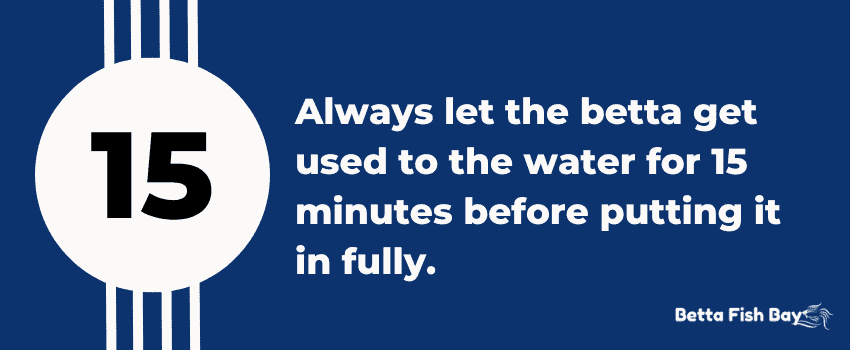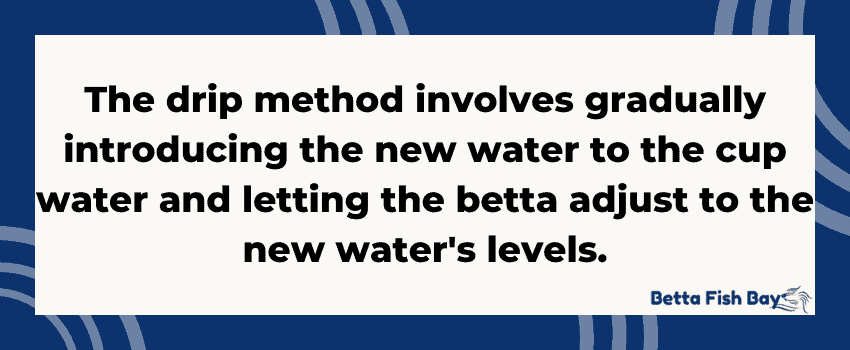Once you bring home your new pet betta fish, you’ll need to safely transfer it into a tank. Betta cannot live very long in a small cup due to how quickly the little bit of water becomes toxic.
We will look at a couple of different methods on how to transfer betta fish from cup to tank.
Beginning such a tedious process is stressful, but we’re here to walk you through it and facilitate your success.
Follow the instructions in this article to help transfer and acclimate your betta to its new tank.

Table of Contents
Why Should You Transfer Your Betta Into a Tank?
You may be wondering why transferring your betta fish into a tank right away is so important. After all, most store-bought fish live in cups or bags when you buy them.
Betta fish are a sensitive fish species requiring specific water parameters to thrive. The longer your betta is cooped up in a small container, the more its feces accumulates.
This accumulation causes a buildup of the toxin ammonia.
Additionally, fish thrive in oxygenated water, as supported by the Florida Department of Agricultural and Consumer Services.
When water is stagnant—like in your betta’s cup—it loses oxygen. While bettas do better in unoxygenated water than other fish, they still require at least minimal oxygen levels.
For these reasons, you must transfer your new betta immediately.
How Long Can a Betta Fish Live in a Cup?
While betta fish can technically last up to a few weeks in a cup with frequent water changes, transferring them within 24 hours is best.
Holding off puts your betta at greater risk of experiencing water toxicity and dying.
The longer a betta fish remains in a small cup or bag, the more its feces build up. This causes increased ammonia levels, which can cause ammonia poisoning in fish.
To ensure your betta lives a long, healthy life, transfer it to a tank as soon as possible.
It’s critical to do this correctly and take all the necessary precautions; otherwise, your betta may not acclimate well.
How to Safely Transfer Your Betta Fish

Two primary methods for transferring betta are the water switch method and the drip method.
Here is a detailed overview of each method.
The Water Switch Method
The standard method of transferring betta from cup to tank is the easier and cheaper method. While it’s typically successful, it does have a greater chance of failure than the drip method.
1. Choose a Tank
Your betta will require a tank with a capacity of at least 2.5 gallons, though we recommend opting for a 5-gallon fish tank or larger. The larger tanks are better and give them space to swim more!
Bettas require plenty of space to live their best lives.
2. Prepare the Tank
Preparing your betta’s new tank involves a few different steps:
- Wash the tank and any decorations thoroughly using warm water and soap.
- Pour a layer of gravel onto the bottom of the tank.
- Put decorations inside the tank.
Note: Ensure the gravel you use in the tank is a neutral color and opt for finer-grain gravel.
Neutral colors will decrease your betta’s stress levels, and beneficial bacteria will grow better on smaller gravel particles.
3. Fill the Tank with Tap Water
Because tap water is unfiltered, it contains the full range of nutrients betta fish require. Mineral water, on the other hand, lacks the essential minerals your betta needs.
Note: We recommend purchasing a water conditioner like this one and applying it to the water as you fill the tank.
The conditioner removes bleach, a deadly toxin, from the water to ensure the tank is safe for your betta.
4. Float the Cup in the Tank for 15 Minutes
To begin the acclimation process, carefully place the cup containing your betta into the tank, so it floats at the top.
Doing so allows your betta to acclimate to the temperature range of the new tank water, which is likely colder than the cup water.

5. Pour Some Tank Water Into the Cup
After fifteen minutes, pour a small amount of the tank water into the cup.
This is to help your betta get used to the pH level of the new water, as it’s likely different from the cup water’s pH level.
Note: The ideal pH level for a healthy betta fish tank is between 6.5 and 7.5. Purchase a water pH meter to ensure the tank and water quality is safe for your new betta fish.
6. Add Some More Tank Water
After about fifteen minutes, add a little bit more water from the tank into the cup. Adding this second batch of water will ensure your betta is well-acclimated to the new water.
7. Transfer The Tropical Fish from Cup to Tank
Do this using a fishnet, and be gentle with the betta while transferring it.
The Drip Method

The drip method of transferring betta is more effective than the standard method.
This said, you will need to purchase some special equipment and give yourself plenty of time if you opt for this method.
The idea behind the drip method is to siphon water from the new tank into a container holding the cup with the betta.
This will allow the betta to gradually be introduced to the new water as it covers it in the container.
1. Put the Open Cup in a Large Container
The container must be large enough to hold enough siphoned water to cover your fish. It should ideally have a wide mouth so the betta can breathe properly during the exercise.
2. Place the Container Beside the Fish Tank
Once you have the betta’s cup inside the container, place the container beside the new fish tank.
Also, put an air stone in the container, which will better oxygenate the water and ensure the safety of your betta.
3. Create a Makeshift Siphon
Now it’s time to create a makeshift siphon. You will need this siphon to initiate the acclimation process. There are a few different ways to do this. Refer to the video below for a quick tutorial:

Note: There are also plenty of fish aquarium siphons like this one available to purchase if you’re not into DIY projects!
4. Begin Siphoning Water from the Tank to the Container
Now, put one end of the siphon in the tank and the other end in the container with the betta. Now start siphoning the water into the container, ensuring the water flows at a slow but steady rate.
5. Test the Water
Once enough water has been siphoned to cover the betta fish, test the water in the tank to ensure it’s within all of the necessary parameters.
Ideal Water Parameters for a Betta Fish Tank Include the following:
- Temperature: 78-80° degrees Fahrenheit (25.5-27° C)
- pH: 6.5-7.5
- Ammonia and Nitrite: 0 ppm
- Nitrate: < 40 ppm
- gH: 3-4 dGH (50-66.7 ppm)
- kH: 3-5 dKH (53.6-89.4 ppm)
- Minimum Tank Size: 5 Gallons
Read more in detail in our guide to betta water parameters.
6. Place the Cup in the Tank
Now, place the open cup containing your betta into the tank. The betta has now been acclimated to the aquarium’s water temperature and pH level, so it’s safe to let it free in the tank.
Let the fish wander out independently, then remove the cup once it appears comfortable in its new home.
What To Do After the Transfer
Watch your betta closely for the next several hours or days following the transfer to ensure it has acclimated well to its new environment.
Watch for these common signs of disease in betta during and after the acclimatization period:
- Lack of energy
- Loss of appetite
- Abdominal swelling
- Increased aggression
- Discoloration or fading color
- Damaged or clamped fins
- Labored breathing
If your betta seems to be doing fine, you’ve successfully transferred your betta from cup to tank!
What if you notice your betta is exhibiting these common distress signs? In this case, there are steps to take to help nurse your betta fish back to health:

It’s Time to Introduce Your Betta to Its New Home
Betta fish require specific conditions from their living environment, such as a soft-to-neutral pH level and a moderate temperature.
Using either of these methods for how to transfer betta fish from cup to tank should ensure the good health of your new pet.
Before all this, though, you need your betta tank set up correctly. We’ve got a guide at the link you need to see to avoid major problems with your fish later on.


